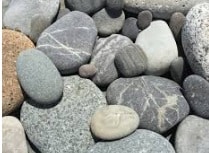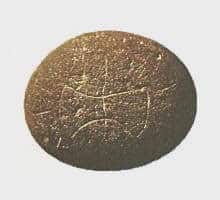 A pebble is a small-sized boulder . A boulder, in turn, is a stone that, based on the impulse given by the water, rolls and smoothes out, acquiring a rounded shape.
A pebble is a small-sized boulder . A boulder, in turn, is a stone that, based on the impulse given by the water, rolls and smoothes out, acquiring a rounded shape.
Pebbles, therefore, are loose pieces of rock that are transported by water currents by various means. These movements that occur naturally give them a characteristic morphology, in which no edges are recorded due to the erosion they suffer when moving.
Due to their characteristics, pebbles are given different uses. In construction , they are used for pavements and plasters since they facilitate stacking and adhere easily to cement or concrete.
Children, on the other hand, often use pebbles in the game of throwing stones into the water in such a way that they bounce several times before sinking. This entertainment is known as making a frog , making a frog , making a duck , making a chata , or making a goat .
When throwing the pebble, you want the stone to bounce and move forward before submerging. Ideally, the launch should be done near the surface of the liquid, and not from very high up. The pebble, upon encountering the surface tension of water , does not sink immediately.
Pebbles, finally, were used as weapons by the slingers of Ancient Rome . These soldiers had different slings to throw stones: the pebbles, due to their shape, could travel great distances through the air.
In 1994, the so-called Kafkania pebble was found in Greece, more precisely in the archaeological site known as Olympia, located in the peripheral unit of Elis. On this stone we can see a small inscription with eight syllabic signs whose reading has not been precisely determined but it is estimated that it should be a-so-na / qo-ro-qa / qa-jo .
 On the other side of the Kafkania pebble we see a labrys , that is, a Greek symbol that looks like a double-edged axe. The ancient Greeks called it sagaris or pelekys , and in the Roman Empire it was known as bipennis . There are several representations of the labrys, beyond the one present on the Kafkania pebble, dating from the Paleolithic and Neolithic periods; They are generally associated with the mother goddess, that is, of fertility.
On the other side of the Kafkania pebble we see a labrys , that is, a Greek symbol that looks like a double-edged axe. The ancient Greeks called it sagaris or pelekys , and in the Roman Empire it was known as bipennis . There are several representations of the labrys, beyond the one present on the Kafkania pebble, dating from the Paleolithic and Neolithic periods; They are generally associated with the mother goddess, that is, of fertility.
Among the scholars of this peculiar discovery there are those who suggest that qo-ro-qa , part of the inscription found on one of its faces, is a personal name, although it is not known if it is male or female, nor if It is about the owner of the pebble. Regarding the date in which we can contextualize it, it is estimated that it is the 17th century BC. C., which would be the oldest text testimony of its kind.
The Kafkania pebble belongs to mainland Greece, and the writing system it contains is known as Linear B , which was used for documents in the phase of the Greek language called Mycenaean Greek . Linear B was used especially in the administrative field, between the 17th and 12th centuries BC. C., long before the alphabet emerged as a form of organization and writing of the Greek language.
It should be noted that some experts in the field believe that the Kafkania pebble is not authentic, but rather a forgery made in modern times. Among the reasons that gave rise to suspicions is the coincidence of a-so-na with lasonas , the name of one of the children of those who discovered this stone.
